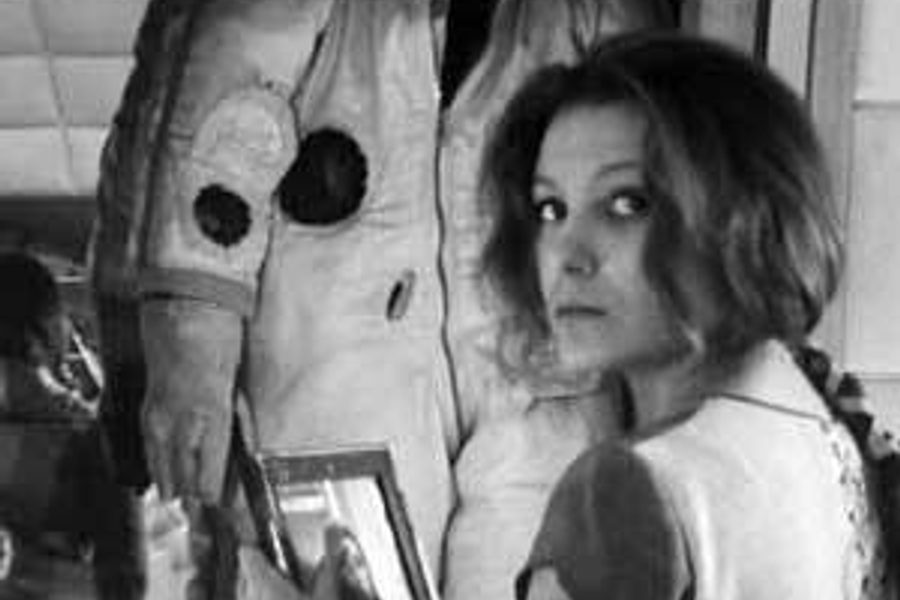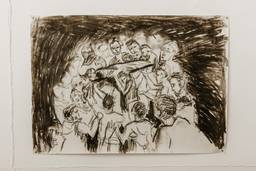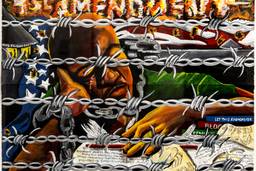
Readers of these pages need no introduction to Michael Moore, nor will they require any acrobatics on my part to go see Bowling for Columbine, which is (brace yourselves) pretty terrific.
That’s not to say we’re an uncritical bunch—we can be plenty toxic toward our own kind—but Moore’s latest, about America’s fatal obsession with guns, has few genuine weaknesses. They’re there, to be sure: a whiff of self-congratulatory end-zone dancing here, the occasional flat-footed irony elsewhere. But so too is a ferocious (and ferociously funny) indictment of good-old American fear-mongering—the kind that’s spooked us into suspending gradeschoolers for ominously waving a loaded chicken finger in the cafeteria, and led us right up to the brink of war.
What really must be discussed here are tactics: Moore will never be called a subtle documentarian, but this is why his critics consider him a dangerous man. There he is, strutting out of his Michigan bank branch hoisting a rifle (free with each new checking account), and you can tell he’s pleased with himself. Bowling for Columbine revs up almost immediately on a raft of potent absurdities—too many for any reviewer to possibly spoil—least of all a certificate of membership to the National Rifle Association, proudly signed by the filmmaker himself, a lifetime member. If that comes as a surprise to you, wait until you see the adorable hunting dog with guns strapped to its back (the master was hospitalized), or the Lockheed-Martin employee gravely pondering the roots of school violence from the weapons factory floor in Littleton; a giant missile looms behind him.
This last bit propels Moore onto more speculative ground, a welcome development despite the clear entertainment value of militia yahoos and ammo-selling barbershops. We cut from the missile man to a montage of covert CIA interventions—from Pinochet to Saddam to Osama—and those burning towers at the end make it a little hard to bear, especially in the mocking musical context of Louis Armstrong’s “What a Wonderful World.” (This is a movie that also shows us surveillance camera footage from the Columbine massacre—not set to music, thankfully.) Considering that Bowling will shortly be playing in malls across the country, the provocation seems close to heroic.
————–
So it’s interesting to watch Moore back off from that argument as he returns again to the question of guns. America does have a blood-soaked history, he concedes, but is it any worse than the imperial spillings of Britain or Japan? (Both countries have annual gun casualties in the mere dozens, this to our thousands.) Nor should we point the finger at victimized rocker Marilyn Manson, who pulls off the greatest shock of his career by revealing himself to be an uncommonly thoughtful social critic. You might as well blame bowling, Moore suggests, another pastime the Columbine killers engaged in—and the very thing they did before heading off to school that April morning.
No, Moore’s chosen culprit—and it’s a good one—is the incessant burble of dread pouring from the nightly news and tabloids, scaring us literally to death. It’s here that Bowling begins to resemble a grade-Z horror film, as the media madness comes in a flood: Y2K doomsday scenarios, killer “Africanized” bees, superhungry sharks, even the quiet threat of escalators (“Stairway to Danger,” screams a special report).
The producer of the smash show Cops balks at Moore’s suggestion that they go after corporate criminals, stating with brutal honesty that they could never get white-collar perps to take their shirts off. So much easier for TV to sell the roving crackhead, the black rapist, the madman dictator—and Moore never lets us forget that killings are being made, by burglar-alarm installers, gun manufacturers and Lockheed-Martin.
Compare it all to Canada’s broadcasts, where politicians drone on about boring things like international diplomacy and health care, and Moore seems to have a point. How else to explain the sole gun death that occurred last year in the city of Windsor, while right across the water sits America’s murder capital, Detroit? Canadians love their guns, but they don’t appear to want to kill each other. They don’t even lock their front doors, a rumor Moore gets great mileage out of proving, bursting unannounced into several Toronto homes.
The last house on his list belongs to God: To watch Charlton Heston blame the violence on our “mixed ethnicity” is to hear a terrible moan rise from the audience—it’s Moore’s greatest triumph.
That’s not to say we’re an uncritical bunch—we can be plenty toxic toward our own kind—but Moore’s latest, about America’s fatal obsession with guns, has few genuine weaknesses. They’re there, to be sure: a whiff of self-congratulatory end-zone dancing here, the occasional flat-footed irony elsewhere. But so too is a ferocious (and ferociously funny) indictment of good-old American fear-mongering—the kind that’s spooked us into suspending gradeschoolers for ominously waving a loaded chicken finger in the cafeteria, and led us right up to the brink of war.
What really must be discussed here are tactics: Moore will never be called a subtle documentarian, but this is why his critics consider him a dangerous man. There he is, strutting out of his Michigan bank branch hoisting a rifle (free with each new checking account), and you can tell he’s pleased with himself. Bowling for Columbine revs up almost immediately on a raft of potent absurdities—too many for any reviewer to possibly spoil—least of all a certificate of membership to the National Rifle Association, proudly signed by the filmmaker himself, a lifetime member. If that comes as a surprise to you, wait until you see the adorable hunting dog with guns strapped to its back (the master was hospitalized), or the Lockheed-Martin employee gravely pondering the roots of school violence from the weapons factory floor in Littleton; a giant missile looms behind him.
This last bit propels Moore onto more speculative ground, a welcome development despite the clear entertainment value of militia yahoos and ammo-selling barbershops. We cut from the missile man to a montage of covert CIA interventions—from Pinochet to Saddam to Osama—and those burning towers at the end make it a little hard to bear, especially in the mocking musical context of Louis Armstrong’s “What a Wonderful World.” (This is a movie that also shows us surveillance camera footage from the Columbine massacre—not set to music, thankfully.) Considering that Bowling will shortly be playing in malls across the country, the provocation seems close to heroic.
————–
So it’s interesting to watch Moore back off from that argument as he returns again to the question of guns. America does have a blood-soaked history, he concedes, but is it any worse than the imperial spillings of Britain or Japan? (Both countries have annual gun casualties in the mere dozens, this to our thousands.) Nor should we point the finger at victimized rocker Marilyn Manson, who pulls off the greatest shock of his career by revealing himself to be an uncommonly thoughtful social critic. You might as well blame bowling, Moore suggests, another pastime the Columbine killers engaged in—and the very thing they did before heading off to school that April morning.
No, Moore’s chosen culprit—and it’s a good one—is the incessant burble of dread pouring from the nightly news and tabloids, scaring us literally to death. It’s here that Bowling begins to resemble a grade-Z horror film, as the media madness comes in a flood: Y2K doomsday scenarios, killer “Africanized” bees, superhungry sharks, even the quiet threat of escalators (“Stairway to Danger,” screams a special report).
The producer of the smash show Cops balks at Moore’s suggestion that they go after corporate criminals, stating with brutal honesty that they could never get white-collar perps to take their shirts off. So much easier for TV to sell the roving crackhead, the black rapist, the madman dictator—and Moore never lets us forget that killings are being made, by burglar-alarm installers, gun manufacturers and Lockheed-Martin.
Compare it all to Canada’s broadcasts, where politicians drone on about boring things like international diplomacy and health care, and Moore seems to have a point. How else to explain the sole gun death that occurred last year in the city of Windsor, while right across the water sits America’s murder capital, Detroit? Canadians love their guns, but they don’t appear to want to kill each other. They don’t even lock their front doors, a rumor Moore gets great mileage out of proving, bursting unannounced into several Toronto homes.
The last house on his list belongs to God: To watch Charlton Heston blame the violence on our “mixed ethnicity” is to hear a terrible moan rise from the audience—it’s Moore’s greatest triumph.
Joshua Rothkopf has been covering cinema for In These Times since 1999. His work has appeared in The Village Voice, The Chicago Reader, Isthmus and City Pages, among other publications.







